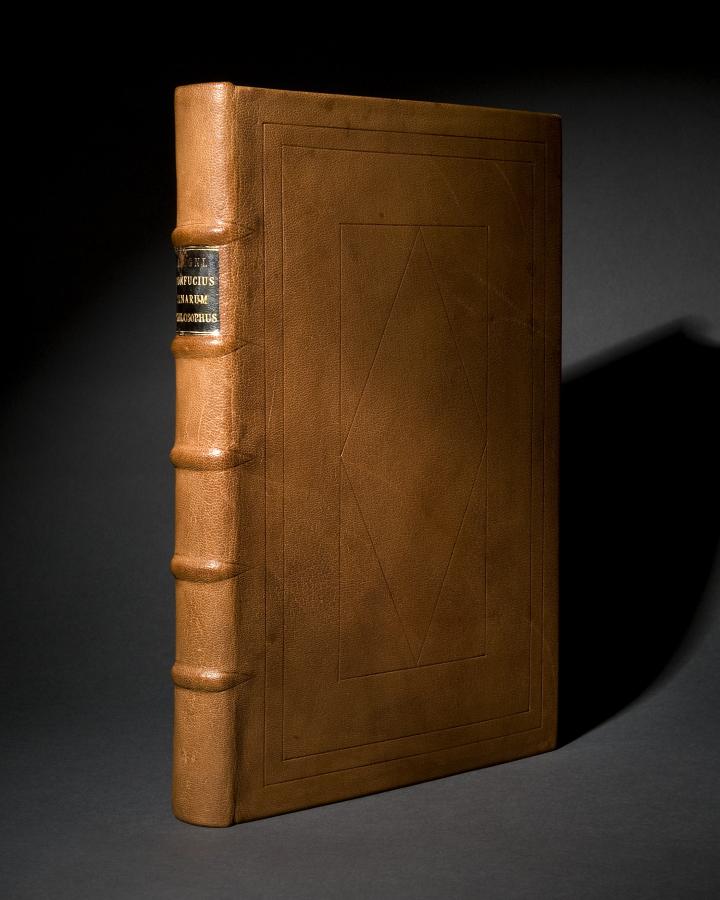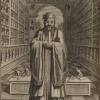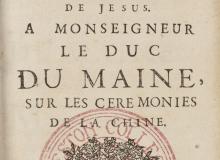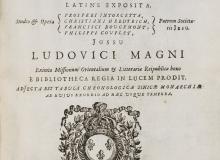Confucius Sinarum



The full Latin title of this work is Confucius sinarum philosophus, sive, Scientia sinensis latine exposita, that is Confucius the philosopher of China, or, the knowledge of China translated into Latin.
In 1687, in Paris, the printer Daniel Horthemels printed the first edition of this significant work. It was the first substantial translation of the Confucian canon into European languages, in this case the common language of scholarship, Latin. It was printed with royal privilege and was dedicated to Louis the XIV, destined for the library of the Sun King, as a gift to his fine republic of letters.
The titlepage states that the book was the product of the labors of four Jesuit priests who were missionaries in China: Philippe Couplet (1623-1693), Christian Herdtrich (1625-1684), Prospero Intorcetta (1625-1696) and Francis Rougemont (1624-1676). That is two Belgians, an Italian and an Austrian who by the time of publication had between them spent around 75 years in China. Herdtrich and Rougemont were already dead before the book saw the light of day, Couplet died six years later off the coast of Goa as a result of a shipboard accident (on his return to China) and only Intorcetta outlived the moment. Intorcetta died in 1696, having spent 37 years in China, or at least working for the China mission, given that he returned to Europe as procurator between 1671 and 1674. He was a significant figure in the church’s mission in Jiangnan, especially Hangzhou, which at the time was also an important place of publication for Jesuit Chinese language works.
Thus, the publication was not a whimsical, slipshod thing done on the spur of a moment. Nor in fact was this compilation the product of just the intellectual collaboration of only these four men. Rather, it was the culmination of decades of translation work by Jesuit missionaries since the days of the pioneer Michel Ruggieri (1543-1607), Ricci’s predecessor. As each new wave of Jesuit missionary scholars arrived in China they were able to delve deeper into Chinese intellectual culture, being the beneficiaries of their brethren’s earlier lessons about cultural immersion and linguistic competency. The Society of Jesus’ structure enabled a sustained and intense academic engagement with China’s philosophical tradition, especially as that was expressed through the Confucian canon.
(Here is not the place to analyze what exactly the Jesuits made of these works, nor in fact is it the place to introduce and explain what the Confucian classics are. This website is simply a means to introduce general readers to the primary texts themselves. Scholars of eastern philosophy, likewise, will also be happiest with unfettered access to the text).
In conclusion, however, two final points can be made about why the Jesuits bothered translating these texts and not others, and why the book was dedicated to Louis XIV.
The Jesuits in China quickly realized that, according to a principle known as the cultural imperative, they needed to immerse themselves into Chinese culture and be accepted by the scholars, who were the arbiters of what was (or was not) orthodox. To do this they also needed to separate themselves from Buddhism, a situation that was itself the product of another cultural phenomenon known as ‘the inflated difference.’ That is, although they wished to be known as men of wisdom and religion, they needed to show that they were not of that religion, Buddhism. They were different, but not so different as to be considered heterodox. Thus, in order to immerse themselves into the culture and be accepted, they needed to understand that culture, and this was to be done through intense study of the seminal texts that underlay that culture. This was one reason for the attention to Confucianism, although the fact that the study of these texts was the pathway for all Chinese scholars also made it the logical choice.
The other reason for choosing these texts was that Ricci, and others after him, perceived that there was a certain similarity between some of the Confucian precepts and Christian teachings. Like the biblical story of Paul preaching in the Areopagus, the Jesuits thought they could talk of Christianity within a Confucian milieu. Hence they made the choice to translate these texts, although in so choosing they were also responding to their own needs as well. These translations subsequently impressed and influenced a generation of European scholars like Wolff, Voltaire and Leibniz, among others. Whenever such scholars used the word ‘Confucian’ they were also paying silent homage to the long Jesuit labours.
The dedication to Louis XIV was a very calculated move, one in a long line of tactical planning by the Jesuits in China (and indeed everywhere). They realized that they needed the support of significant people, not only to fund their endeavours around the word, but also to provide protection in times of political hardship. Dedicating this significant intellectual work to Louis XIV was but one way of impressing upon the French King the worthiness of their pursuits and their desire for his further support. It was also an ambitious ploy that paid off because Couplet, one of the authors, was also the one responsible for bringing the text to Europe and so he was able to give the work to the king himself. He did this in the company of a Chinese convert, Michael Shen Fuzong, who also impressed upon the king the results of the Jesuit labours in China.
In the next year, six French Jesuits were sent to Asia by the Sun King, as his personal mathematicians, to promote science, the glory of the French crown and of the gospel too. The dedication was wisely done indeed.
How to Use the Online Books
A help page explaining the difference between the book readers and how to use the scholarly search.
Related Items

The Chinese Rites Controversy was about missionary methods. Louis Le Comte (1655-1728) wrote this letter to gain support for the Jesuits.

Translation of Confucian classics into European languages
Jesuit missionaries began translating the Confucian canon in 1583. The first work that transmitted this knowledge to Europe was published in Paris in 1687.
